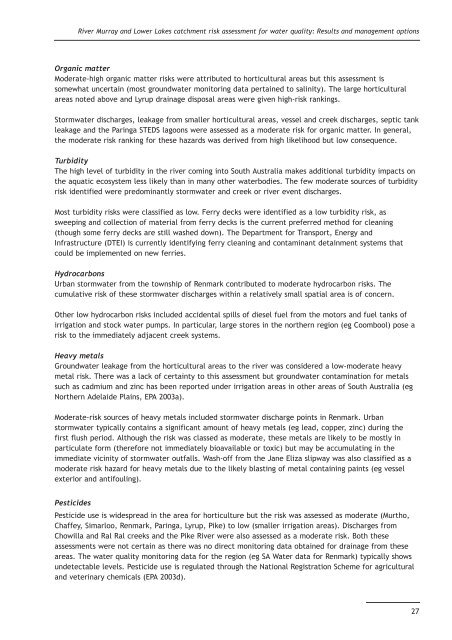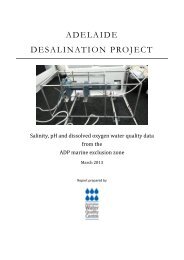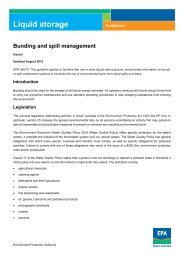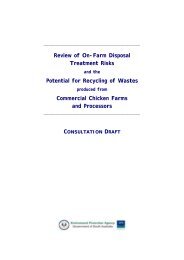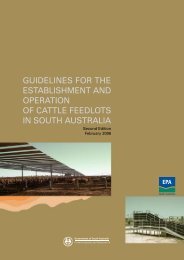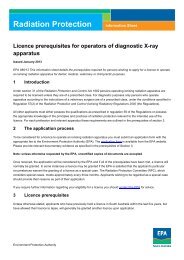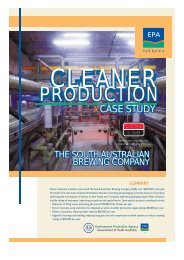2 Renmark to border LAP area assessment - EPA - Sa.gov.au
2 Renmark to border LAP area assessment - EPA - Sa.gov.au
2 Renmark to border LAP area assessment - EPA - Sa.gov.au
You also want an ePaper? Increase the reach of your titles
YUMPU automatically turns print PDFs into web optimized ePapers that Google loves.
River Murray and Lower Lakes catchment risk <strong>assessment</strong> for water quality: Results and management options<br />
Organic matter<br />
Moderate-high organic matter risks were attributed <strong>to</strong> horticultural <strong>area</strong>s but this <strong>assessment</strong> is<br />
somewhat uncertain (most groundwater moni<strong>to</strong>ring data pertained <strong>to</strong> salinity). The large horticultural<br />
<strong>area</strong>s noted above and Lyrup drainage disposal <strong>area</strong>s were given high-risk rankings.<br />
S<strong>to</strong>rmwater discharges, leakage from smaller horticultural <strong>area</strong>s, vessel and creek discharges, septic tank<br />
leakage and the Paringa STEDS lagoons were assessed as a moderate risk for organic matter. In general,<br />
the moderate risk ranking for these hazards was derived from high likelihood but low consequence.<br />
Turbidity<br />
The high level of turbidity in the river coming in<strong>to</strong> South Australia makes additional turbidity impacts on<br />
the aquatic ecosystem less likely than in many other waterbodies. The few moderate sources of turbidity<br />
risk identified were predominantly s<strong>to</strong>rmwater and creek or river event discharges.<br />
Most turbidity risks were classified as low. Ferry decks were identified as a low turbidity risk, as<br />
sweeping and collection of material from ferry decks is the current preferred method for cleaning<br />
(though some ferry decks are still washed down). The Department for Transport, Energy and<br />
Infrastructure (DTEI) is currently identifying ferry cleaning and contaminant detainment systems that<br />
could be implemented on new ferries.<br />
Hydrocarbons<br />
Urban s<strong>to</strong>rmwater from the <strong>to</strong>wnship of <strong>Renmark</strong> contributed <strong>to</strong> moderate hydrocarbon risks. The<br />
cumulative risk of these s<strong>to</strong>rmwater discharges within a relatively small spatial <strong>area</strong> is of concern.<br />
Other low hydrocarbon risks included accidental spills of diesel fuel from the mo<strong>to</strong>rs and fuel tanks of<br />
irrigation and s<strong>to</strong>ck water pumps. In particular, large s<strong>to</strong>res in the northern region (eg Coombool) pose a<br />
risk <strong>to</strong> the immediately adjacent creek systems.<br />
Heavy metals<br />
Groundwater leakage from the horticultural <strong>area</strong>s <strong>to</strong> the river was considered a low-moderate heavy<br />
metal risk. There was a lack of certainty <strong>to</strong> this <strong>assessment</strong> but groundwater contamination for metals<br />
such as cadmium and zinc has been reported under irrigation <strong>area</strong>s in other <strong>area</strong>s of South Australia (eg<br />
Northern Adelaide Plains, <strong>EPA</strong> 2003a).<br />
Moderate-risk sources of heavy metals included s<strong>to</strong>rmwater discharge points in <strong>Renmark</strong>. Urban<br />
s<strong>to</strong>rmwater typically contains a significant amount of heavy metals (eg lead, copper, zinc) during the<br />
first flush period. Although the risk was classed as moderate, these metals are likely <strong>to</strong> be mostly in<br />
particulate form (therefore not immediately bioavailable or <strong>to</strong>xic) but may be accumulating in the<br />
immediate vicinity of s<strong>to</strong>rmwater outfalls. Wash-off from the Jane Eliza slipway was also classified as a<br />
moderate risk hazard for heavy metals due <strong>to</strong> the likely blasting of metal containing paints (eg vessel<br />
exterior and antifouling).<br />
Pesticides<br />
Pesticide use is widespread in the <strong>area</strong> for horticulture but the risk was assessed as moderate (Murtho,<br />
Chaffey, Simarloo, <strong>Renmark</strong>, Paringa, Lyrup, Pike) <strong>to</strong> low (smaller irrigation <strong>area</strong>s). Discharges from<br />
Chowilla and Ral Ral creeks and the Pike River were also assessed as a moderate risk. Both these<br />
<strong>assessment</strong>s were not certain as there was no direct moni<strong>to</strong>ring data obtained for drainage from these<br />
<strong>area</strong>s. The water quality moni<strong>to</strong>ring data for the region (eg SA Water data for <strong>Renmark</strong>) typically shows<br />
undetectable levels. Pesticide use is regulated through the National Registration Scheme for agricultural<br />
and veterinary chemicals (<strong>EPA</strong> 2003d).<br />
27


